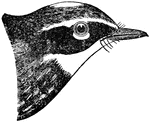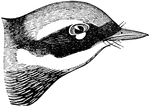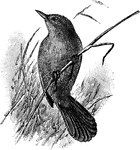186 illustrations of birds including: wagtail, warbler, waxwing, weaver-bird, wheat-ear, whinchat, whippoorwill, widgeon, widow-bird, woodcock, woodlark, woodpecker, woodsnipe, wren, wrentits, wryneck, and yellow-throat

Golden-Crested Wren
Also known as the Kinglet, the Golden-Crested Wren (Regulus cristatus) is the smallest of European birds.…

Wagtail
This wagtail is remarkable for the vibratory motion of their body while standing or walking, (Figuier,…

Wagtail
This wagtail is remarkable for the vibratory motion of their body while standing or walking, (Figuier,…

Wagtail
This wagtail is remarkable for the vibratory motion of their body while standing or walking, (Figuier,…

Wagtail
This wagtail is remarkable for the vibratory motion of their body while standing or walking, (Figuier,…

Yellow Wagtail
"Motacilla raii, the Yellow Wagtails, are generally black and white, grey and white, grey with a yellow…
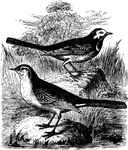
A White and Yellow Wagtail Sitting on the Rocks
A (Motacilla alba) or White Wagtail (upper) and a (Motacilla flava) Yellow Wagtail (lower) sitting on…

Yellow Wagtail Head and Foot
"The Yellow Wagtail or Motilla flava has characters of the Motacilla alva; tail shorter, not exceeding…

Plain Wanderer
Pedionomus torquatus differs in structure from Turnix by the presence of a small hind-toe. The lax upper…
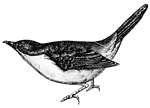
Warbler
Its song is loud, cheerful, and much diversified, night being generally selected for the display of…

Black and White Warbler
The Black-and-white Warbler, Mniotilta varia, is a small New World warbler. It breeds in northern and…

Black and White Warbler
"Mniotilta varia, the Black and White Warbler, The general coloration is olive-green, grey, or slaty-blue,…

Black Throated Green Warbler
A small bird usually 4 to 6 inches in length with endless varied in coloration, migratory, insectivorous,…

Black-capped Fly-catching Warbler
"Myiodioctes pussies. Blacked-capped Fly-catching Warbler. Upper parts, including exposed edging of…

Black -poll Warbler
"Black-poll Warbler or Dendroica striata. Back, rump, tail-coverts grayish-olive, heavily streaked with…

Black-throated Gray Warbler
"Black-throated Gray Warbler or Dendroica nigrescens. Above, bluish-ash, the interscapular region, and…

Black-throated Green Warbler
The Black-throated Green Warbler, Dendroica virens, is a small songbird of the New World warbler family.…

Blue Golden-Winged Warbler
"Blue Golden-Winged Warbler or Helminthophila chrysoptera. Upper parts slaty-blue, or or fine bluish-gray;…

Blue-Winged Yellow Warbler
Found from Louisiana to New Jersey, the blue-winged yellow warbler migrates south to tropical parts…
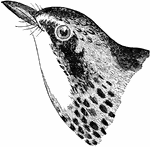
Canada Warbler
"Myiodioctes canadensis. Canadian Fly-catching Warbler. Canada Warbler. Bluish-ash; crown speckled with…

Chestnut-sided Warbler
The Chestnut-sided Warbler, Dendroica pensylvanica, is a New World warbler. They breed in eastern North…

Chestnut-sided Warbler
"Chestnut-sided Warbler, Dendroica pensylvanica. Back streaked with black and pale yellow (sometimes…
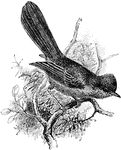
Dartford Warbler
The Dartford Warbler, Sylvia undata, is a typical warbler from the warmer parts of western Europe, and…
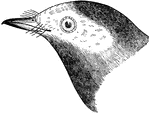
Hooded Warbler
"Myiodioctes mitratus. Hooded Fly-catching Warbler. Hooded Warbler. Clear yellow-olive above; below,…

Kentucky Warbler
"Kentucky Warbler. Oporornis formosus. Clear olive-green; entire under parts bright yellow, olive-shaded…

Magnolia Warbler
"Black -and-Yellow Warbler. Magnolia Warbler. Back black, usually quite pure and uninterrupted in the…

Myrtle Warbler
The Myrtle Warbler, Dendroica coronata coronata, is a small New World warbler. This passerine bird was…

Nashville Warbler
The Nashville Warbler, Vermivora ruficapilla, is a small songbird in the New World warbler family. They…

Painted Fly-catching Warbler
"Painted Fly-catching Warbler. Setophaga picta. Painted Redstart. Lustrous black; middle of breast and…

Pine Warbler
It is about 6 iches long and of an olive green color above and a dull yellow color below.

Pine Warbler
The Pine Warbler, Dendroica pinus, is a small songbird of the New World warbler family. These birds…

Prothonotary Warbler
A beautiful bird of a rich yellow color, passing by degrees through olivaceous tints on te rump, wings,…

Reed Warbler
Nesting in the reeds near bodies of freshwater, the reed-warbler can be found in Middle and Southern…

Reed Warbler
"Warbler is a popular name often applied to well-known singing birds of northern climes, whose notes…

Sedge Warbler
The Sedge Warbler (Acrocephalus schoenobaenus) is a small passerine bird in the Sylviidae family.

Worm-Eating Warbler
"Worm-Eating Warbler or Helmitheros vermivorus. Olive, below buffy, paler or whitish on the belly; head…

Yellow Warbler
The Yellow Warbler (Dendroica petechia) is a New World warbler. It is the most widespread Dendroica…

Yellow Browed Warbler
A bird with twelve rectrices, yellow axillaries, and the greater wing coverts with pale tips.

Yellow-rumped Warbler
"Yellow-rumped Warbler or Dendroica coronata. Yellow-crowned Warbler. Myrtle Bird. Slaty-blue, streaked…

Warblers
The name applied to a family of perching birds, most of which are shy, small, and active, and have a…

Warblers Eating Caterpillars
An illustration of warblers feeding on the young caterpillars of the Gipsy moth.




